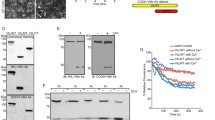Abstract
Besides the morphological changes in cells undergoing apoptosis, such as chromatin condensation and cell shrinkage, histological demonstration of DNA fragmentation by in situ end labeling (ISEL) has been widely used for the demonstration of apoptotic cells in tissue sections. Although DNA fragmentation can be demonstrated in apoptotic cells and apoptotic bodies in most cases, there is no clear correlation of ISEL staining with apoptosis. It has often been demonstrated that, in many morphologically intact cells, nuclei with fragmented DNA can be found. Thus staining with ISEL for the detection of apoptosis is useful only in connection with other markers for apoptosis as, for example, characteristic morphological changes. Here we show that tissue transglutaminase protein is unequivocally expressed in apoptotic enterocytes as shown by DNA fragmentation and morphology. Tissue transglutaminase is not expressed in enterocytes with healthy morphology, although DNA fragmentation can be demonstrated in these cells. Thus the immunohistochemical demonstration of tissue transglutaminase may serve as a simple marker for apoptotic epithelial cells in tissue sections.
Similar content being viewed by others
Author information
Authors and Affiliations
Additional information
Electronic Publication
Rights and permissions
About this article
Cite this article
Aschoff, A., Günther, E. & Jirikowski, G. Tissue transglutaminase in the small intestine of the mouse as a marker for apoptotic cells. Colocalization with DNA fragmentation. Histochem Cell Biol 113, 313–317 (2000). https://doi.org/10.1007/s004180000140
Accepted:
Published:
Issue Date:
DOI: https://doi.org/10.1007/s004180000140




